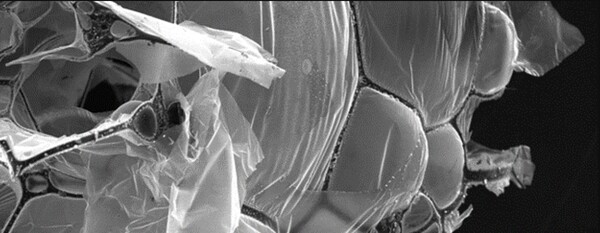계란 흰자 사용해 가볍고 다공성인 재료 만들어…
해수에서 98% 효율로 염분 제거 및 99% 효율로 미세 플라스틱 제거해

프린스턴 대학교의 한 연구팀은 일반적인 식재료를 이용해 해수에서 염분과 미세 플라스틱을 저비용으로 제거할 수 있는 새로운 방법을 발견했다고 밝혔다.
연구원들은 달걀 흰자를 사용해 물 여과, 에너지 저장, 소음 및 단열재을 포함한 많은 응용 분야에서 사용할 수 있는 가볍고 다공성 물질인 에어로겔을 만들었다.
크레이그 아놀드(Craig Arnold) 수석 저자이자 엔지니어는 "어느 날 한 회의에 참석해 샌드위치에 들어 있는 빵을 바라보고 있었다"라며, "그리고 이것이 바로 우리에게 필요한 구조라고 생각했다"고 연구를 시작한 과정에 대해 설명했다. 아놀드는 자신이 찾고 있는 에어로겔 구조를 재현할 수 있는지 확인하기 위해 연구팀에 탄소와 혼합된 다양한 빵 조리법을 만들어 달라고 요청했다. 많은 실험 후에 연구팀은 '계란 흰자'라는 답을 찾을 수 있었다.
계란 흰자는 산소가 없는 환경에서 동결 건조되고 섭씨 900도까지 가열될 때 탄소 섬유와 그래핀 시트의 상호 연결된 구조를 생성하는 거의 순수한 단백질의 복잡한 시스템으로 이뤄졌다. 연구팀은 결과적으로 98%의 효율로 해수의 염분을 제거하고 99%의 효율로 미세 플라스틱을 제거할 수 있다고 밝혔다.
다른 단백질도 이러한 상호 연결된 구조를 만들 수 있는데, 이는 이 물질이 잠재적으로 식품 공급에 영향을 미치지 않고 상대적으로 저렴하게 대량으로 생산될 수 있다는 것을 의미한다. 다음 단계 연구는 제조 공정을 정제하여 더 큰 규모로 정수에 사용할 수 있도록 하는 것이다.
아놀드는 물의 순도를 "주요 도전 과제"로 보고 있지만, 이것이 유일한 잠재적 응용 분야는 아니다. 또한 에너지 저장 및 단열과 관련된 다른 용도를 모색하고 있다.
이 연구에는 분자 수준에서 달걀 흰자 단백질의 변형 메커니즘을 식별하는 데 도움을 준 화학 및 생물 공학 공동 작업자들의 기여가 포함됐다. 아놀드는 "실험실에서 무언가를 만드는 것과 그 이유와 방법을 이해하는 것은 또 다른 일"이라고 말했다.
한편, 이 연구는 프린스턴 복합소재센터(Princeton Center for Complex Materials)의 보조금을 통해 미국 국립과학재단(U.S. National Science Foundation, NSF)에서 부분적으로 지원받았다. 연구 결과는 『머터리얼 투데이(Materials Today)』에 발표됐다.
[원문보기]
Researchers cook up a new way to remove microplastics from water
Team used egg whites to create a lightweight, porous material
Researchers at Princeton University have found a way to turn a common breakfast food into a new material that can cheaply remove salt and microplastics from seawater.
The researchers used egg whites to create an aerogel, a lightweight and porous material that can be used in many applications, including water filtration, energy storage and sound and thermal insulation.
The research was supported in part by the U.S. National Science Foundation through a grant to the Princeton Center for Complex Materials. Results of the research are published in Materials Today.
Sitting in a meeting one day, engineer and lead author Craig Arnold had an idea. "I was sitting there, staring at the bread in my sandwich," said Arnold. "And I thought, this is exactly the kind of structure we need." He asked his lab group to make different bread recipes, mixed with carbon, to see if they could recreate the aerogel structure he was looking for. After much testing, the team found their answer: egg whites. "It was the proteins in the egg whites that were leading to the structures we needed," Arnold said.
Egg whites are a complex system of almost pure protein that — when freeze-dried and heated to 900 degrees Celsius in an environment without oxygen — create a structure of interconnected strands of carbon fibers and sheets of graphene. Arnold and his co-authors showed that the resulting material can remove salt from seawater with 98% efficiency and remove microplastics with 99% efficiency.
Other proteins could also create this interconnected structure, which means that the material could potentially be produced in large quantities relatively cheaply and without impacting the food supply. A next step is to refine the fabrication process so it can be used in water purification on a larger scale.
While Arnold sees water purity as a "major grand challenge," it is not the only potential application. He is also exploring other uses related to energy storage and insulation.
The research included contributions from collaborators in chemistry and biological engineering who helped identify the transformation mechanism of the egg white proteins at the molecular level. "It's one thing to make something in the lab," said Arnold, "and it's another thing to understand why and how."
[출처 = NSF(https://beta.nsf.gov/news/researchers-cook-new-way-remove-microplastics) / 2023년 1월 18일]

